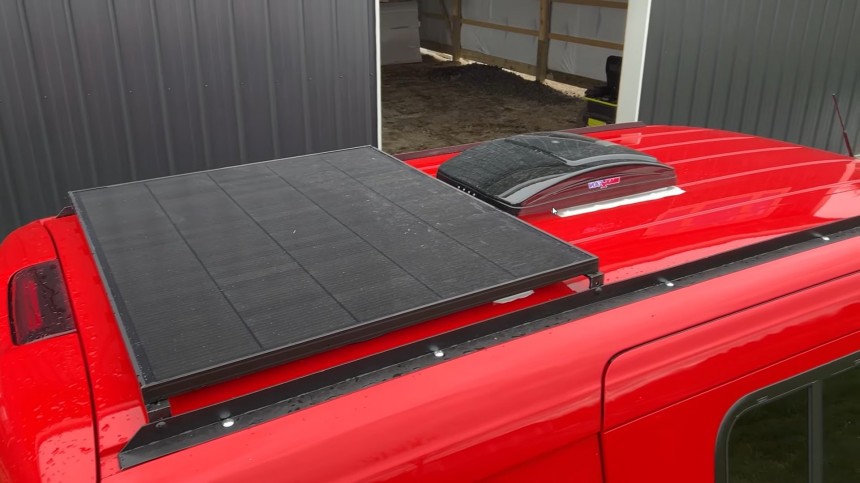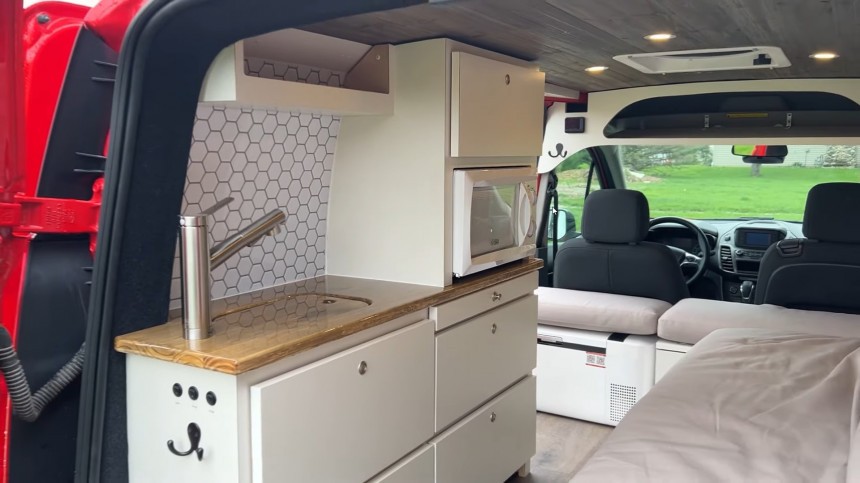The way I see it, micro camper vans are the toughest rigs to build due to the very limited space; you have to maximize every single inch inside. Still, with some creativity, preparation, and a proper budget, anyone can do it. But sure, it helps to have some experience with these types of conversions. Today, I'm taking a look at the latest project from a company that specializes in building micro camper vans.
What we have here is a Ford Transit Connect transformed into a mobile home by Small Vans Big World, a Valparaiso, Indiana-based company that creates custom camper vans. It was founded by Daniel and Christina, a married couple with the goal of making van life accessible to anyone and everyone.
On the outside, this rig doesn't scream "camper van." In fact, most people won't be able to tell that someone's living or traveling inside this vehicle. There are some elements that could give away its "camper DNA," at least to someone who's familiar with campers.
I'm talking about a Maxxair Deluxe vent fan and a 200 W solar panel on the roof. There are also two windows on the sides, one on each door. By the way, this Ford Transit Connect has two sliding doors. However, only the one on the driver's side can serve as an entrance, as the other is partly blocked by the couch and its backrest.
Step inside the van, and you'll discover a compact yet surprisingly well-furnished interior. It has an open layout, meaning there's no wall separating the living space from the driver's cabin.
Regarding aesthetics, this van's interior consists of laminate flooring paired with a shiplap cedar ceiling, white laminate cabinetry, and light grey upholstery. All these elements combine to create a neutral, calming design.
In the driver's cabin, the duo didn't make any drastic modifications. They installed a sizeable headliner shelf and created a setup for the most distinctive feature of this micro camper van: an A/C.
"What's so special about an A/C?" you might be wondering. Well, micro camper vans typically don't have enough power or space to fit a roof A/C, as we see on larger vans. But Daniel and Christina came up with a clever solution.
They got a Zero Breeze portable A/C, which is stored in a cabinet. When they want or need some cool air, they fold down the passenger seat, place the A/C on top, and connect it to power.
Daniel and Christina also created a template from a quarter-inch piece pf plywood that goes inot the passenger side window. It has two holes, where the A/C's ducts go. And that's it, the A/C is ready to cool off the whole interior.
Behind the driver and passenger seats, you'll find what looks like two benches. I said, "what looks like" because one is, in fact, an Iceco chest-style fridge/freezer with a cushion on top.
The remaining part of the living space is split into two parts: a kitchen/storage area on the driver's side and a seating/sleeping area on the other. The latter consists of a couch with three compartments underneath: two are for storage, while one houses a portable PortaPotti toilet. There's also a slide-out table that can be pulled out through the rear, outside the rig.
Turning the couch into a bed is very straightforward. All you have to do is undo a latch underneath and pull – the frame will slide out, and it will be supported by the edge of one of the drawers in the kitchen. The result is a spacious bed with a 3-inch memory foam mattress measuring 43 inches (109 centimeters) in width and more than 72 inches (182 centimeters) in length.
The kitchen features a tiny sink with a cover that matches the epoxy countertop, a microwave, a slide-out table, and a white tiled backsplash. On one side of the counter, you'll find plugs, an inverter controller, a battery monitor, and some switches.
By the way, the sink is fed by a 14-gallon (53-liter) freshwater tank and drains into a 2.5-gallon (9.4-liter) greywater tank mounted underneath the vehicle.
For storage, you can use four large lower cabinet, an overhead cabinet, and an overhead shelf. One of the lower cabinets houses the electrical system – its highlights are a 100 Ah lithium battery bank, a 1,500 W inverter, a DC-DC charger, and a solar charge controller.
It's not extremely powerful, but it will do the job, especially since the battery can be charged via solar and from the alternator while driving.
Overall, Small Vans Big World did a great job with this micro camper van conversion. It integrates all the essentials, and that A/C setup is genius. It's too small, at least for most people, to serve as a full-time mobile home, but it can definitely be a lovely part-time rig for weekend or even week-long escapades.
On the outside, this rig doesn't scream "camper van." In fact, most people won't be able to tell that someone's living or traveling inside this vehicle. There are some elements that could give away its "camper DNA," at least to someone who's familiar with campers.
I'm talking about a Maxxair Deluxe vent fan and a 200 W solar panel on the roof. There are also two windows on the sides, one on each door. By the way, this Ford Transit Connect has two sliding doors. However, only the one on the driver's side can serve as an entrance, as the other is partly blocked by the couch and its backrest.
Step inside the van, and you'll discover a compact yet surprisingly well-furnished interior. It has an open layout, meaning there's no wall separating the living space from the driver's cabin.
In the driver's cabin, the duo didn't make any drastic modifications. They installed a sizeable headliner shelf and created a setup for the most distinctive feature of this micro camper van: an A/C.
"What's so special about an A/C?" you might be wondering. Well, micro camper vans typically don't have enough power or space to fit a roof A/C, as we see on larger vans. But Daniel and Christina came up with a clever solution.
They got a Zero Breeze portable A/C, which is stored in a cabinet. When they want or need some cool air, they fold down the passenger seat, place the A/C on top, and connect it to power.
Behind the driver and passenger seats, you'll find what looks like two benches. I said, "what looks like" because one is, in fact, an Iceco chest-style fridge/freezer with a cushion on top.
The remaining part of the living space is split into two parts: a kitchen/storage area on the driver's side and a seating/sleeping area on the other. The latter consists of a couch with three compartments underneath: two are for storage, while one houses a portable PortaPotti toilet. There's also a slide-out table that can be pulled out through the rear, outside the rig.
Turning the couch into a bed is very straightforward. All you have to do is undo a latch underneath and pull – the frame will slide out, and it will be supported by the edge of one of the drawers in the kitchen. The result is a spacious bed with a 3-inch memory foam mattress measuring 43 inches (109 centimeters) in width and more than 72 inches (182 centimeters) in length.
By the way, the sink is fed by a 14-gallon (53-liter) freshwater tank and drains into a 2.5-gallon (9.4-liter) greywater tank mounted underneath the vehicle.
For storage, you can use four large lower cabinet, an overhead cabinet, and an overhead shelf. One of the lower cabinets houses the electrical system – its highlights are a 100 Ah lithium battery bank, a 1,500 W inverter, a DC-DC charger, and a solar charge controller.
It's not extremely powerful, but it will do the job, especially since the battery can be charged via solar and from the alternator while driving.





















